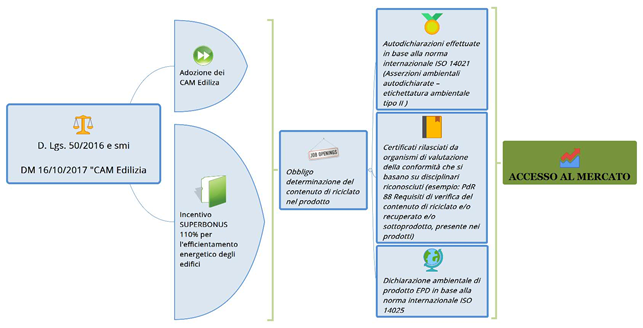The world of construction is particularly stimulated by theCircular Economy both by the CAM front both by the Superbonus front.
For companies that produce products for the construction industry, a Circular Economy is achieved by implementing actions to improve efficiency in the use of resources and prevent or reduce the negative impact linked to the generation and management of waste, through the recycling of the same as well as the reuse of production and processing waste, allowing its enhancement and continuous innovation.
The obligation to include the Minimum Environmental Criteria in the design and tender documentation of public contracts came into force on 20 April 2016 with the "new" Procurement Code (Legislative Decree 50/2016). For the construction sector, the CAM the legislative reference is given by the “CAM EDILIZIA” (DM 11/10/2017).
In Legislative Decree 50/2016 and smi, with a questionable simplifying assumption it is believed that recovered / recycled material = benefit to the environment, and that it is such as to trigger the virtuous circle of theCircular Economy.
Specifically, the content of recovered or recycled material in the materials used for the building,[...]must be equal to at least 15% by weight evaluated onthe total of all materials used (of which at least 5% must be made of non-structural materials).
In CAM Construction there are specific rules for the concretesused for the project (minimum content of recycled material of at least 5% on the weight of the sum of the individual product components that actually remains in the final product), thermal and acoustic insulators (with recycling components differentiated from 1% to 80% depending on the materials of which they are made: cellulose, glass wool, stone wool, ... rubber agglomerates), bricks, plastic components, stone and mixed masonry, partitions and false ceilings.
The 100% Superbonus is a facilitation provided for by the 2020 Relaunch Decree that raises to 110% the deduction rate of expenses incurred from 1 July 2020 to 30 June 2022, for specific interventions in the field of energy efficiency, anti-seismic interventions, installation of photovoltaic systems or infrastructure for recharging electric vehicles in buildings. To obtain the facilitation, in the energy efficiency works of the building, thermal insulation materials compliant with the "CAM Edilizia" must be used; in practice CAM enter the private market..
In order not to run into misleading labels, which have flourished in recent times, the safest way for manufacturers and economic operators in general (e.g.: importers) is to legitimize the recycled content through increasingly elaborate communication tools such as:
- simple self-declarations made on the basis of the international standard ISO 14021 (Self-declared environmental claims – type II environmental labelling), possibly certified by a conformity assessment body;
- certificates issued by conformity assessment bodies that are based on recognized specifications (e.g.: Re-Made in Italy): to try to clarify the methodology for calculating the recycled content, UNI issued in 2020 the Reference Practice UNI/PdR 88:2020 Requirements for verifying the content of recycled and / or recovered and / or by-product, present in the products;
- EPD environmental product declaration according to the international standard ISO 14025 (Environmental labels and declarations – Type III environmental labeling) certified by accredited third parties. This environmental communication tool is the most recognizable by the market as the most advanced.
Without going too much into the technical merits, it should be noted that in the Environmental Product Declarations he recycled content is only one of the environmental aspects to be considered in the broader system of calculation of the environmental impacts related to the production, use and end of life of the construction product that is obtained from a timely LCA (Life Cycle Assessment) analysis. With this tool other important environmental aspects of the Circular Economy (use of natural substances and / or innovative raw materials, low energy production, ecodesign, durability, recyclability, etc.) are taken into account and appropriately valued as well as the recycled content.
It should be emphasized that the LCA studies are the technical reference to demonstrate the environmental goodness of the buildings present in the drafts of the new CAM for construction being approved by the competent Ministry

To learn more about the tools you can use, do not hesitate to contact us at info@lca-ambiente.com or info@scfinternational.itour team of experts can accompany you to make your products compliant.
